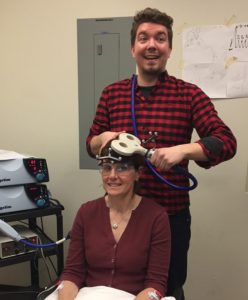
A Brief Description
TMS uses a coil on your head to non-invasively stimulate an area of your brain, most commonly used in this lab the area of the brain that represents the motor region of your arm or hand. It can be a bit odd at first but has been described as being similar to a reflex tap. You will hear a click and it will cause a small twitch in your arm or hand. We measure this twitch, or muscle activity, by placing electrodes on the muscles of your arm or hand (depending on the study the exact location can vary).
TMS Safety and Risks
Safety standards for the application of TMS have been developed and will be followed by trained operators during this study to minimize the risk. In accordance with these standards, the TMS machine will always be run at a rate and a frequency that are known to be safe.
There is a potential risk of provoking a seizure in people with a history of seizures (e.g. epilepsy). Though there has never been a report of a seizure associated with the type of TMS you receive in our studies (ie., single and paired-pulse TMS), you will not be eligible to participate in this study if you have such history. When using high frequency repetitive TMS, which is not used in our studies, the risk of seizure induction is less than 1% in individuals without epilepsy.
There is a risk of headache, scalp pain, toothache or scalp numbness associated with single and paired-pulse TMS. Each of these side effects is transient (ie., does not last).
The clicks associated with single and paired-pulse TMS are loud and could potentially damage your hearing. To minimize this risk you will be asked to wear earplugs throughout the testing session.
You will not be eligible to have TMS if you have:
- a history of seizures or epilepsy
- a pacemaker or intracardic lines
- metal in the skull
- treatment with amitriptyline or haloperidol